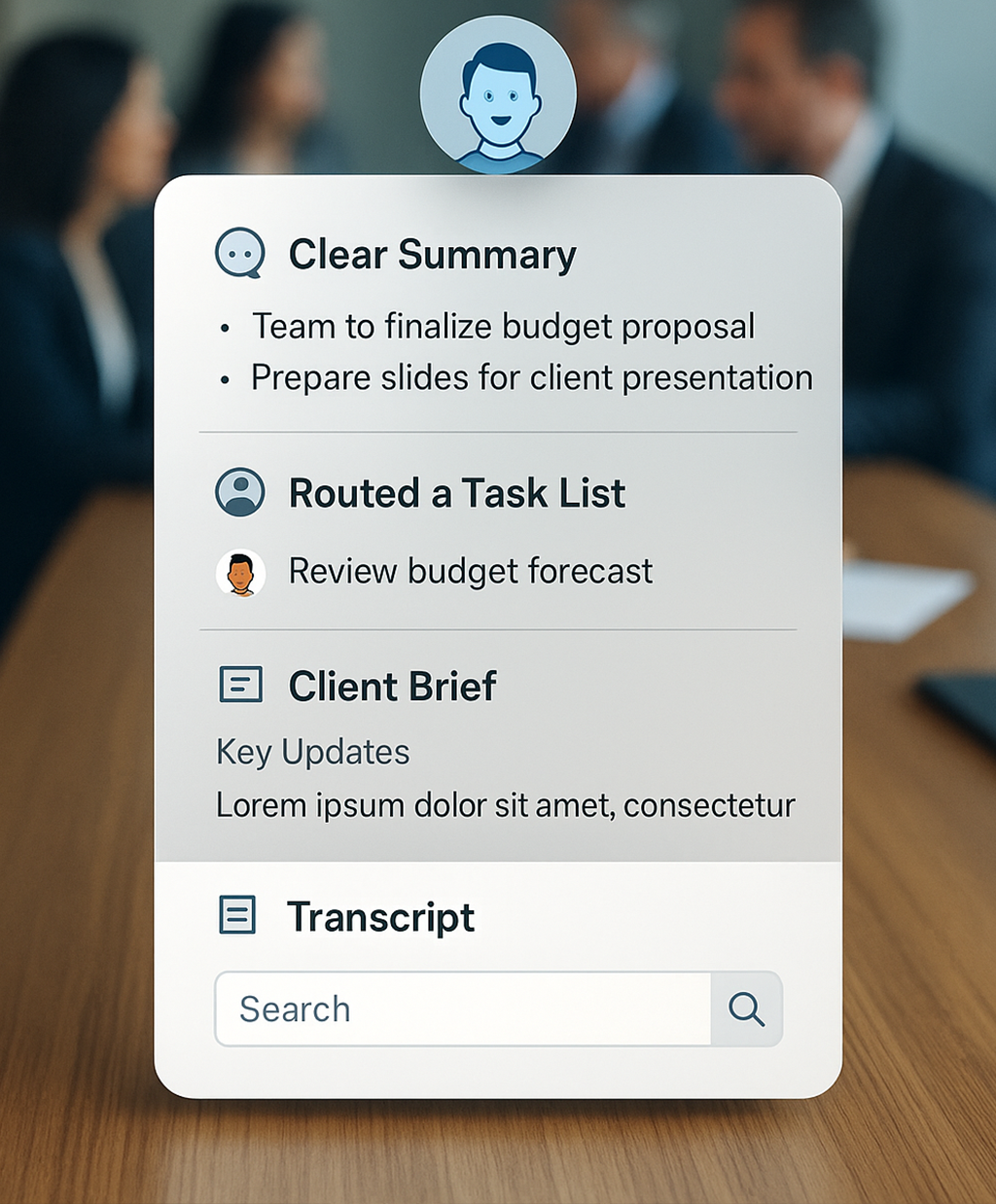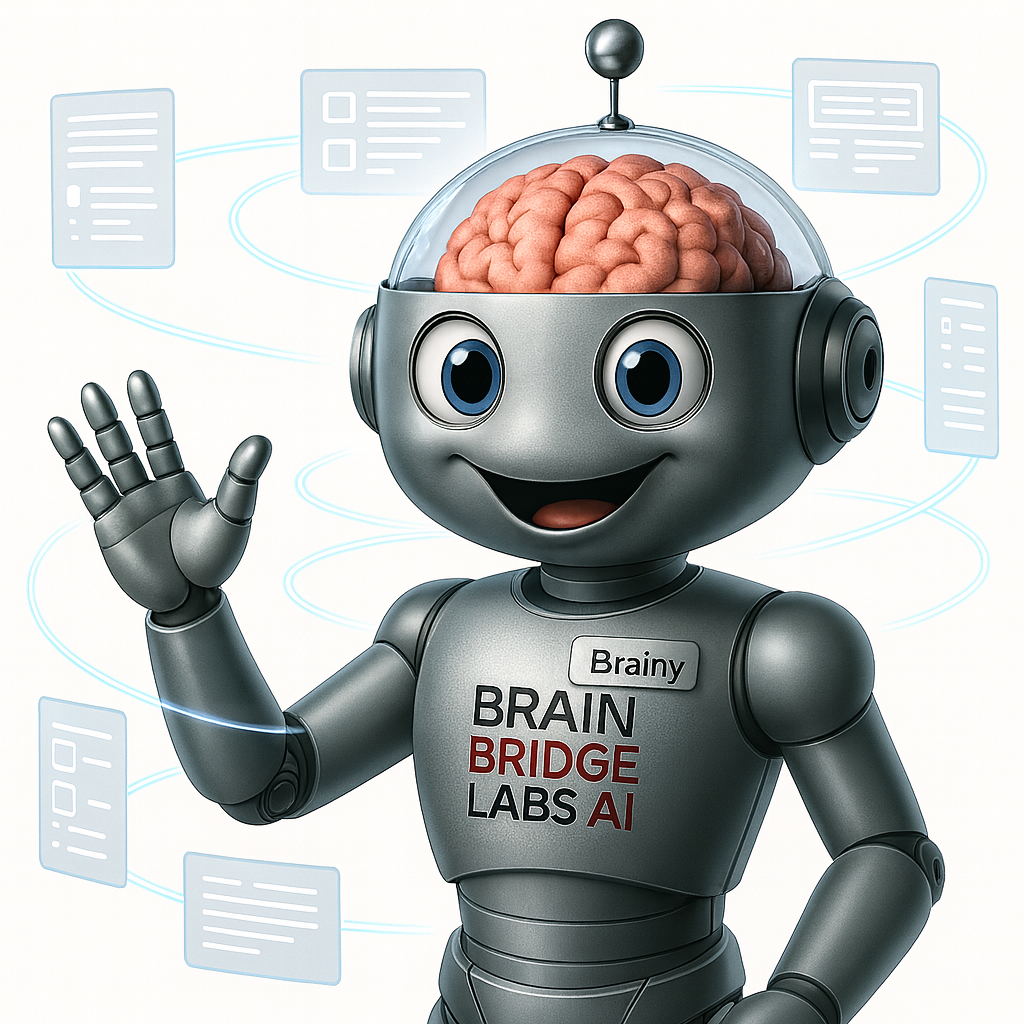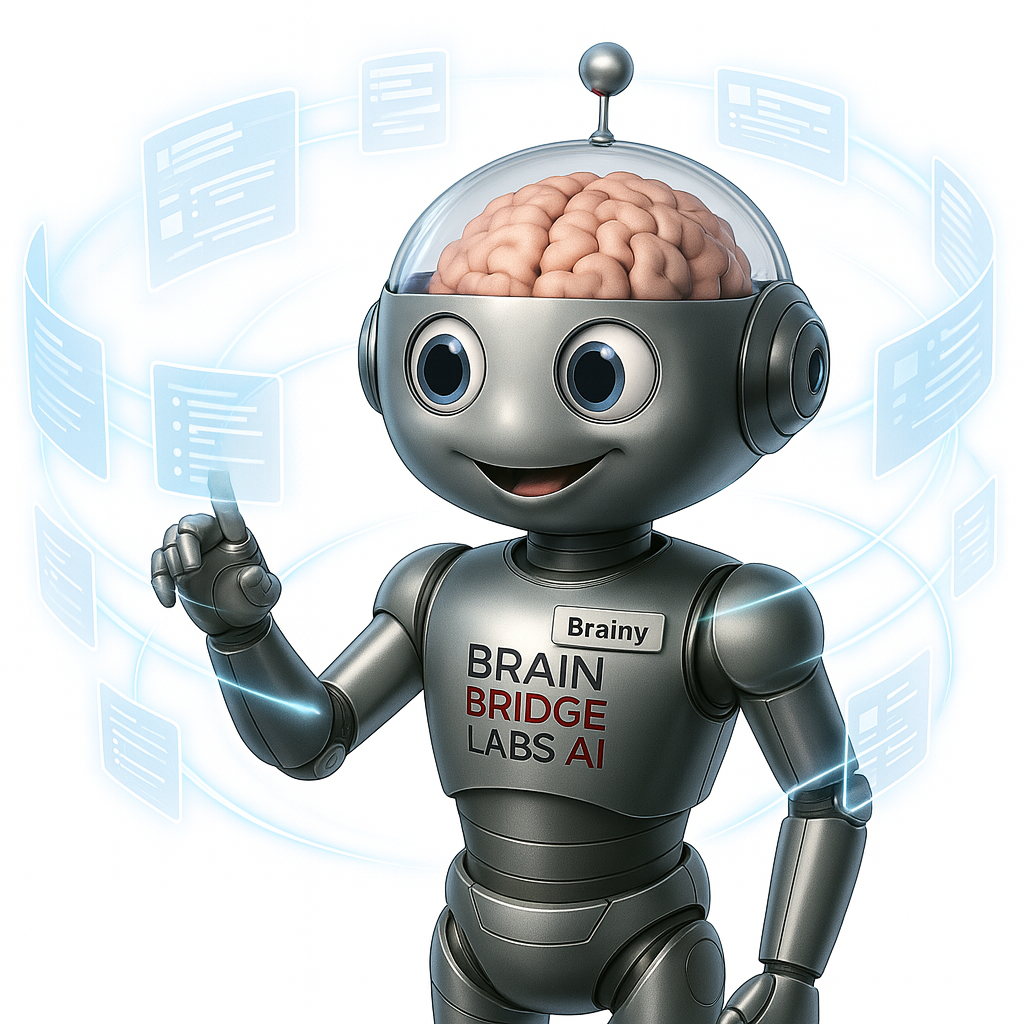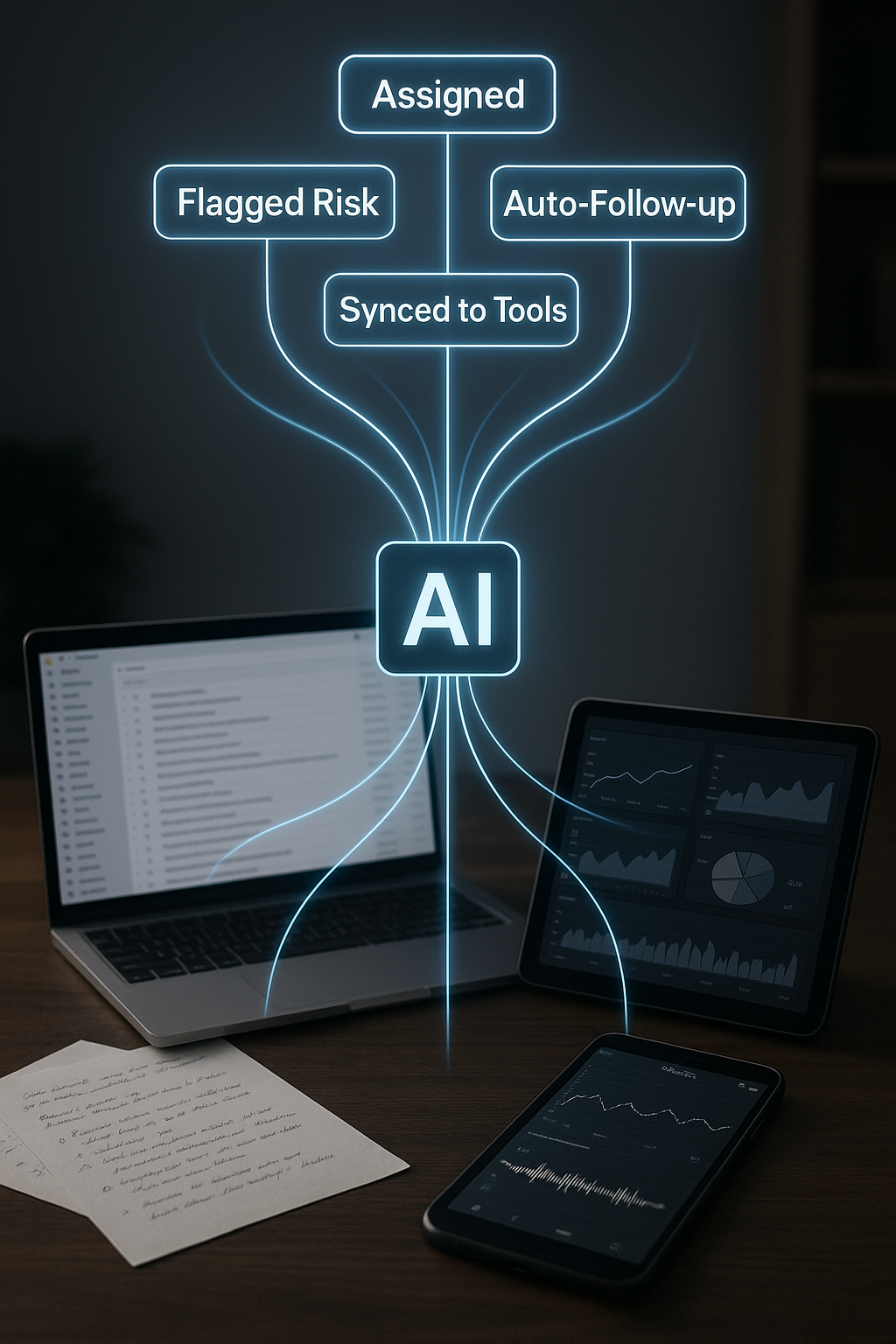INSIGHTS | AI Project Management
Your Client Meetings Are Goldmines
Start Treating Them Like It.
By Josh Brown, Brain Bridge CEO
Published July 15, 2025
TOPLINE
Most teams forget 90% of what happens in meetings. That’s wasted time, missed context, and lost profit. What if every meeting gave you a shareable recap, task list, client brief and training docs without lifting a finger?
Professional service firms rarely run short on meetings. What they often lack is a way to make better use of the data generated in a meeting. Critical signals about project risks, misalignment, or unspoken expectations often vanish once the meeting window closes.
Most teams talk, solve, decide and… forget. That creates delays, missed signals, and rework. What if every conversation auto-generated:
-
A clear summary
-
A task list routed to the right people
-
A client brief with key updates
-
A searchable transcript tied to projects
That shift doesn’t require an overhaul, just smarter tooling. When conversations are captured, analyzed, transformed, and routed to the right places, they stop being fleeting moments and start driving real momentum. The firms doing this well aren’t having more meetings. They’re making quieter ones count.

The problem isn’t the number of meetings or agendas. It’s how fast memories fade.
What was the most important thing you discussed in that client meeting three weeks ago? Calendars seem to fill up with team syncs and client check-ins with ease. They feel productive, but the impact often fades by the next day. Action items end up buried in scribbled personal notebooks or or buried in async docs that never get revisited. Risks get mentioned but not tracked. Follow-ups are scattered across inboxes and apps.
Your team and clients are talking but what happens after? Most meetings leave little to no record, no clarity, and no follow-ups with accountability. The issue isn’t poor habits. It’s human memory. We’re just bad at remembering. We try to compensate with systems but they often blind us by showing too much raw data (like personal meeting note takers and CRM systems). Ironically, the clearest signals and early warnings are hidden in conversations, not system data.
When meetings fade, so do decisions, risks, and opportunities. You’re investing meeting time to talk, decide, solve and unfortunately… to forget. An AI driven transcript system makes sure every meeting generates the right outputs: transcripts, summaries, action items. Automatically. A shared memory doesn’t just take notes. It tags key risks, repeated concerns, and action items then routes them to your inbox, CRM, or PM tool within seconds. Nothing gets forgotten.
When Memory Slips, So Does the Client Relationship.
In high-stakes services work, dropped details don’t just cause rework. They erode trust. You can’t patch that with another meeting or prettier notes. What you need is infrastructure. A Core Memory System that tracks what was said, what was agreed to, and what’s still unresolved.
That’s what the Brain Bridge Core Memory System is designed for. It embeds directly into the tools your team already uses Zoom calls, Slack threads, kickoff workshops, stakeholder reviews and captures the context that typically evaporates.
- Scopes don’t shift silently.
- Decisions and next steps aren’t trapped in someone’s inbox.
- Client approvals aren’t vague memories, they’re documented facts.
Your team stops playing telephone across meetings. The system does the remembering, stitching together the narrative across weeks and workstreams. This isn’t surveillance. It’s not bureaucracy. It’s a failsafe against dropped balls, mismatched expectations, and those moments where everyone swears they “thought we were doing X.” A Core Memory System operationalizes conversations so you deliver what was promised, catch misalignments early, and protect the margin and the relationship.

Remembering Is Not A System
When memory becomes the process, rework will be in the outcome.
The rework often costs more than the system that prevents it. Brain Bridge works with clients to build AI memory infrastructure that pays for itself fast. Core Memory captures key decisions, prevents confusion, and protects your margin from forgettable mistakes. You don’t need a bigger team. You need a better system. We’ll help you build it.
You’re Sitting On A Goldmine Of Profitable Intel
AI notetakers are great but they just take notes. They can’t track patterns, surface shifts, and feed insight straight into workflows or work across projects. The quiet “we’re still catching up,” a casual note about competing priorities or budgets are often missed. These hints often surface in-person but never make it into summaries or CRMs. They reveal trouble spots long before they show up in deliverables. Without a clear way to use the transcripts, the real patterns stay hidden.
- Key concerns are voiced but never logged.
- Recurring issues appear across clients and projects but aren’t connected.
- Action items drift between tools without clear ownership.
- Projects derail while everyone relies on memory.
With a customized AI system, meeting transcripts turn into an accessible, shared team memory, detect early risks, and build momentum. You get all that without having another meeting to cover “what did they say?”

AI That Knows What Deserves Your Attention
Most tools tell you what was said. This helps you shape what happens next.
The AI listens to conversations in real time, then extracts the high-signal moments you care about: what’s at risk, what’s unresolved, and what needs follow-up without anyone on your team worrying about it.
For professional service firms, these systems provide:
-
Unconfirmed decisions are flagged and summarized
-
Scope shifts are tracked across recurring meetings
-
Action items are auto-assigned or routed to the right person
-
Client friction is surfaced before it shows up in deliverables
-
CRMs and PM tools get updated, automatically
Imagine a scenario where a project gradually shifts over three meetings, and key decisions remain unconfirmed. The system picks it up and flags it automatically. No one is left guessing whether a passing comment signals concern. It is tracked, analyzed, and surfaced in the tools you already use.
It doesn’t just create transcripts. It builds context across time, making every conversation easier to act on, refer back to, and trust. Your AI becomes a consistent, behind-the-scenes analyst, helping your team stay ahead of risk and aligned with client expectations.
How a Missed Detail Becomes a Project Risk
The project looked fine on paper. Weekly status meetings were happening. Tasks were moving. Everyone assumed progress was on track. Until the AI flagged a repeated pattern: the same client request for user training had come up in three different meetings, and it still hadn’t been resolved.
The topic? Scope boundaries around a dashboard build. No one had noticed that the team gave slightly different answers on how the client’s team would be trained. No one had realized the client was asking because they were confused about whether training was included in the project and growing frustrated because they didn’t know how to prepare post-launch.
After the third meeting, the AI identified the pattern, linked those conversations and flagged the inconsistency. The account manager was alerted, reviewed the transcripts, aligned messaging with the project team, and clarified the scope before the client escalated or delays hit delivery. This didn’t require another meeting. It was just AI connecting the right threads at the right time for the right people.
When Only One Person Knows, Everyone Holds the Risk.
When context lives in someone’s head, the whole system becomes fragile.
Projects shouldn’t fall apart when someone’s out sick. Brain Bridge can help you build a shared team memory so every meeting, approval, and change is accessible when and where it matters. It’s not just about tracking. It’s about trust, speed, and protecting your margin from the next avoidable mistake.


Your Data is Dead If It Doesn’t Land
Most teams don’t suffer from a lack of data. They suffer from data that never goes anywhere. It’s scattered across inboxes, notes, dashboards, and meeting recordings. It’s fragmented, forgotten, or too noisy to act on. Insights get buried. Follow-ups get missed. Everyone assumes someone else is tracking the thread.
Knowing what was said just isn’t enough. The value only shows up when insight turns into action automatically, and without adding work to someone’s plate. That’s why every AI transcript isn’t just logged. It’s processed, tagged, and routed where it needs to go.
-
Decisions with no clear owner? → Assigned.
-
Risks that span teams? → Flagged and shared.
-
Follow-ups? → Auto-sent with deadlines.
-
Unresolved questions? → Logged as open loops.
-
CRM, PM, and knowledge tools? → Synced.
Instead of asking, “Did we capture that?” or “Who’s following up?”, the right person gets the right insight, at the right time, in the tools they already use.
The Support Docs Can Write Themselves
Even when you’re meeting regularly, critical information drifts across Slack threads, notebooks, and memory. The result: duplicated work, complexity, and growing misalignment. Most project delays don’t come from bad work. They come from broken handoffs, missing context, and repeated conversations no one remembers having.
When manual memory is our foundation, teams lose time re-explaining goals or issues to someone new. They get stressed searching inboxes for the latest version of “what was said” They get stuck waiting for clarification that never comes when it’s needed. A shared memory changes that. When conversations across meetings are captured and stitched together, they create living documentation:
-
Client briefs that evolve with the relationship
-
Checklists that reflect real blockers and action steps
-
Decision logs that resolve debates before they start
-
Training packets built from actual project flow
No more chasing updates or decoding vague notes. You get structured clarity that’s auto-generated based on how your team already works.
Proving It Without The Panic.
You shouldn’t have to choose between doing great work and proving it. If you’ve ever scrambled to find a decision trail, explain who said what, or justify why something wasn’t documented, you’re not alone.
Most systems aren’t built to remember what matters. They create blind spots, not clarity. With every conversation captured and processed, you get:
- Sensitive topics flagged in real time → so you don’t miss them under pressure
- Attribution baked in → who said what, when, and why
- Workflow adjustments → to meet privacy and data retention requirements
- Export-ready documentation → for audits, accountability, or just sleeping better at night
Compliance is no longer just a painstaking requirement. It becomes a built-in advantage that enhances transparency, builds client trust, and protects your reputation without slowing anything down.
Final word: Your conversations are already assets
You have everything you need to make this work. You don’t need more fancy AI tools. You need more from what’s already happening. Every client check-in, internal sync, and project meeting contains the context your team is constantly chasing. We just make it usable.
With AI handling the capture and follow-through, you get:
-
Task lists, briefs, and checklists auto-generated from meetings
-
Risks and unconfirmed decisions surfaced automatically
-
Context preserved across time, tools, and teams
-
Zero behavior change. Zero dashboard fatigue. Just output.
You’ll see impact in your first week. The team will have less rework, faster clarity, and tighter handoffs. And… unlike bloated enterprise platforms, it’s priced for real teams that need real results.

